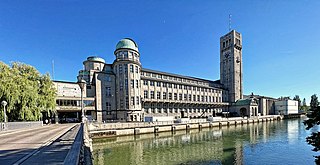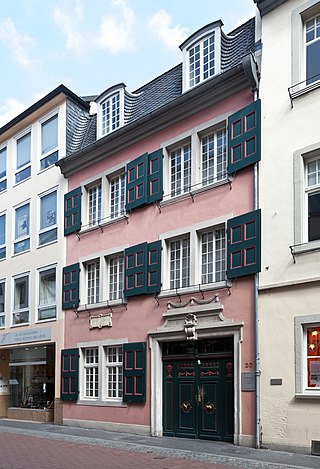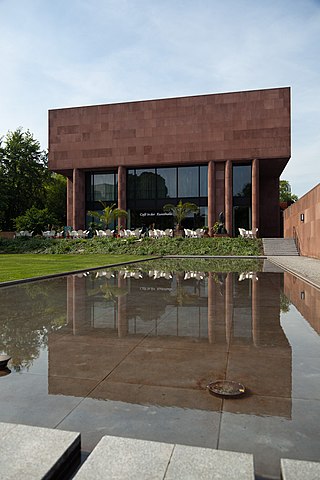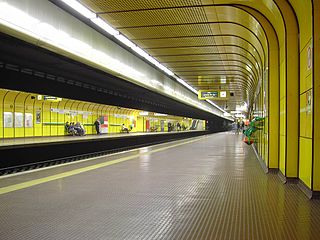
The federal city of Bonn is a city on the banks of the Rhine located in the German state of North Rhine-Westphalia, with a population of over 300,000. About 24 km (15 mi) south-southeast of Cologne, Bonn is in the southernmost part of the Rhine-Ruhr region, Germany's largest metropolitan area, with over 11 million inhabitants. It is a university city, was the birthplace of Ludwig van Beethoven and was the capital of West Germany from 1949 to 1990. Bonn was the seat of government of reunited Germany from 1990 to 1999.

The Rhenish Friedrich Wilhelm University of Bonn is a public research university located in Bonn, North Rhine-Westphalia, Germany. It was founded in its present form as the Rhein-Universität on 18 October 1818 by Frederick William III, as the linear successor of the Kurkölnische Akademie Bonn which was founded in 1777. The University of Bonn offers many undergraduate and graduate programs in a range of subjects and has 544 professors. The University of Bonn is a member of the German U15 association of major research-intensive universities in Germany and has the title of "University of Excellence" under the German Universities Excellence Initiative; it is consistently ranked amongst the best German universities in the world rankings and is one of the most research intensive universities in Germany.

The Deutsches Museum in Munich, Germany, is the world's largest museum of science and technology, with about 28,000 exhibited objects from 50 fields of science and technology. It receives about 1.5 million visitors per year.
The Melbourne Museum is a natural and cultural history museum located in the Carlton Gardens in Melbourne, Australia.

The Bowers Museum is an art museum located in Santa Ana, California. The museum's permanent collection includes more than 100,000 objects, and features notable strengths in the areas of pre-Columbian Mesoamerica, Native American art, the art of Asia, Africa, and Oceania, and California plein-air painting. The Bowers organizes and hosts special exhibitions from institutions throughout the world, and travels exhibitions nationally and internationally. The museum has a second campus two blocks south of the main site, Kidseum, a children's museum with a focus on art and archaeology. The Bowers Museum and Kidseum are located in Santa Ana 6.4 km south of Disneyland.

The German Historical Museum, known by the acronym DHM, is a museum in Berlin, Germany devoted to German history. It describes itself as a place of "enlightenment and understanding of the shared history of Germans and Europeans". It is often viewed as one of the most important museums in Berlin and is one of the most frequented. The museum is located in the Zeughaus (armoury) on the Unter den Linden as well as in the adjacent Exhibition Hall designed by I. M. Pei.

The Kunsthalle Bremen is an art museum in Bremen, Germany. It is located close to the Bremen Old Town on the "Culture Mile". The Kunsthalle was built in 1849, enlarged in 1902 by architect Eduard Gildemeister, and expanded several more times, most notably in 2011. Since 1977, the building has been designated a Kulturdenkmal on Germany's buildings heritage list.

The culture of San Antonio reflects the history and culture of one of the state's oldest and largest cities straddling the regional and cultural divide between South and Central Texas. Historically, San Antonio culture comes from a blend of Central Texas and South Texas (Southwestern) culture. Founded as a Spanish outpost and the first civil settlement in Texas, San Antonio is heavily influenced by Mexican American culture due to Texas formerly being part of Mexico and, previously, the Spanish Empire. The city also has significant German, Anglo, and African American cultural influences. San Antonio offers a host of cultural institutions, events, restaurants and nightlife in South Texas for both residents and visitors alike.

Haus der Geschichte is a museum of contemporary history in Bonn, Germany. With around one million visitors every year, it is one of the most popular German museums. The Haus der Geschichte is, as well as the "Zeitgeschichtliches Forum Leipzig", the "Tränenpalast" am Bahnhof Friedrichstraße and the "Museum in the Kulturbrauerei" part of the Haus der Geschichte der Bundesrepublik Deutschland Foundation. The foundation's place of business is Bonn.

The Beethoven House in Bonn, Germany, is a memorial site, museum, and cultural institution serving various purposes. Founded in 1889 by the Beethoven-Haus association, it studies the life and work of composer Ludwig van Beethoven.

The National Museum of the History of Ukraine illustrates Ukraine's history from ancient times till nowadays. It is one of the leading museums in Ukraine. It holds about 800 000 items in its collection, approximately 22 000 exhibits on permanent display. The museum holds world-famous archaeological, numismatic, ethnographic and weapons collections, pieces of decorative and applied arts, manuscripts, prints, paintings and graphics, relics of the Ukrainian national liberation movement of the 20th century.

The Kunsthalle Bielefeld is a modern and contemporary art museum in Bielefeld, Germany. It was designed by Philip Johnson in 1968, and paid for by the businessman and art patron Rudolf August Oetker.
The Hochschule Bonn-Rhein-Sieg University of Applied Sciences is a German university of applied sciences with more than 9,500 students and 150 professors. Its campus comprises three distinct locations, situated in Sankt Augustin, Rheinbach and Hennef / Sieg.

Heussallee/Museumsmeile is a station on the Bonn Stadtbahn served by SWB lines 63, 66, 67 and 68 and KVB's line 16.

Monika Grütters is a German politician of the Christian Democratic Union (CDU) who served as Federal Government Commissioner for Culture and the Media in the government of Chancellor Angela Merkel from 2013-2021. She has been a member of the German Bundestag since 2005 and was chairwoman of the Committee on Culture and Media Affairs from 2009 to 2013. Since December 2016, Grütters has also been the chairwoman of the CDU Berlin and an elected member of the CDU Federal Executive Board.

Herlinde Koelbl is a German photographic artist, author and documentary filmer.
Detmar Jobst Wilhelm Westhoff is a German art historian and curator. He is very committed to artistic projects that build a bridge between Asia and Europe, to young experimental artists, local cultural policy and monument protection.
Vajiko Chachkhiani is a Georgian artist whose work mostly involves film, sculpture, photography and visual installations. Currently he lives and works in Berlin, Germany and Tbilisi, Georgia. Chachkhiani's work has been shown at the Venice Biennale.
The International Inventories Programme(IIP) is an international research and database project for investigating objects pertaining to the cultural heritage of Kenya that are held in cultural institutions like ethnographic museums across the globe. The programme is jointly run by the National Museums of Kenya in Nairobi, the Rautenstrauch-Joest Museum in Cologne and the Weltkulturen Museum in Frankfurt a. M., both in Germany. To establish a direct relation to contemporary cultural activities both in Kenya and in Germany, the multi-disciplinary arts groups The Nest Collective (Kenya) and SHIFT Collective in Germany and France are further members of the IIP. - The programme and its projects are supported by the Goethe-Institut - German cultural centre in Kenya - and the German Federal Cultural Foundation.
















